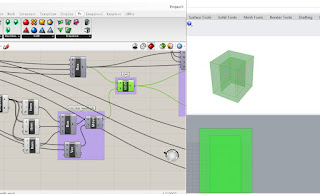ARCH 655 Parametric Modeling in Design Project1-Beijing Water Cube (Yang Shen)
ARCH 655 Parametric Modeling in Design Project1-Beijing Water Cube (Yang Shen)
Beijing Water Cube Introduction
My project1 is Beijing Water Cube which was completed on 28 January 2008. The size of building is 177m x 177m x 31m high. The design of architecture is done by PTW Architects with China State Construction International Design Architectural Design and internal planning. And the engineering part is done by Arup with China State Construction International Design.
Modeling Process
The main idea to get this parametric model starts from: getting a shell; do the Voronoi3D of the box and intersection; model the bubble ETFE façade of outer surface by Weaverbird; do the parametric modeling of frames’ thickness by Weaverbird.
Step 1. Through ‘Domain Box’ to create outer box and inner box and get the shell through ‘Solid Difference’. The parametrical inputs include the length/width/height of outer box and peripheral/top thickness. Here is the screenshot of shell below.
(screenshot of shell)
Step 2. Use ‘Voronoi3D’ to create random cells in the outer box and do the ‘Solid Intersection’ to create the cells only in the shell. The parametrical inputs here are the number of cell and random seeds. Here is the model of Voronoic3D with shell.
Step 3. Next, it is about modeling the bubble ETFE façade of outer surface by Weaverbird. To select the outer surface, an imaginary box which is just little bit smaller from outer box has been created. Then, the ‘Point in Brep’ is used to find the outer surface of cells. To create the bubble shape, centroid point of each outer surface of cells would be extruded outside from the box. Last step is to smooth ETFE façade through ‘Weaverbird Catmull-Clark Subvision’. The parametrical input is the extrusion height proportional to the area of cell’s façade.
(screenshot of extruded surfaces without smoothness)
(screenshot of extruded surfaces with smoothness)
There are two problems during this process:
1. After the ‘solid intersection’ to get the Voronoi3D shell, some centroid points of faces cannot be extruded outside of box because the normal vectors direction is opposite. So the ‘Point in Brep’ is to find the Boolean list of each normal vectors pointing out of box. Then ‘Member Index’ and ‘GhPython Script’ is to find the index of these vectors and do ‘negative’ to get the right direction of normal vectors. (The list method can also be used to solve this problem which is shown in the group with blue color background)
2. Before, the constant of extrusion height is used. But when it comes to small area of cell’s faces, it is not good to see that. So the ‘Remap Numbers’ is used to get the extrusion heights proportional to the area of cell’s façade which is more sensible.
Step 4. Lastly, ‘Weaverbird’s Mesh Thicken’ is to simulate the frames. The parametrical inputs are the width/thickness of frames.
(screenshot of frames)
Finally, the model has been finished. Here are the baked models from different views.












Comments
Post a Comment